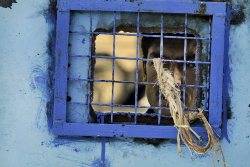Afghan authorities are still torturing prisoners, such as hanging them by their wrists and beating them with cables, the United Nations said, a year after it first documented the abuse and won government promises of detention reform.
The latest report shows little progress in curbing abuse in. The report released Sunday also cites instances where Afghan authorities have tried to hide mistreatment from U.N. monitors.
In multiple detention centers, Afghan authorities leave detainees hanging from the ceiling by their wrists, beat them with cables and wooden sticks, administer electric shocks, twist their genitals and threaten to shove bottles up their anuses or to kill them, the report said.
In a letter responding to the latest report, the Afghan government said that its internal monitoring committee found that "the allegations of torture of detainees were untrue and thus disproved." The Afghan government said that it would not completely rule out the possibility of torture at its detention facilities, but that it was nowhere near the levels described in the report and that it was checking on reports of abuse.
The findings, however, highlight the type of human rights abuses that many activists worry could become more prevalent in Afghanistan as foreign forces draw down.
As one detainee in the western province of Farah told the U.N. team: "They laid me on the ground. One of them sat on my feet and another one sat on my head, and the third one took a pipe and started beating me with it. They were beating me for some time like one hour and were frequently telling me that, 'You are with Taliban and this is what you deserve.'"
More than half of the 635 detainees interviewed had been tortured, according to the report titled Treatment of Conflict-Related Detainees in Afghan Custody: One Year On. That is about the same ratio the U.N. found in its first report in 2011.
"Torture cannot be addressed by training, inspections and directives alone," said Georgette Gagnon, the head of human rights for the U.N. mission in Afghanistan, explaining that there has been little follow-through by the Afghan government.
In particular, the U.N. report found that the Afghan government appeared to be trying to hide the mistreatment and refusing to prosecute those accused of torturing prisoners.
The U.N. team received "multiple credible reports" that in some places detainees were hidden from international observers in secret locations underground or separate from the main facility being inspected. Also, the observers said they saw what appeared to be a suspicious increase in detainees held at police facilities when an intelligence service facility nearby was being monitored.
And particularly in the southern province of Kandahar, the U.N. received reports that authorities were using unofficial sites to torture detainees before transporting them to the regular prison.
The report documents what it called a "persistent lack of accountability for perpetrators of torture," noting that no one has been prosecuted for prisoner abuse since the first report was released.
Aimal Faizi, a spokesman for the Afghan president, said torture and abuse of prisoners was not Afghan policy.
"However, there may be certain cases of abuse and we have begun to investigate these cases mentioned in the U.N. report," he said. "We will take actions accordingly."
But he said that while the Afghan government takes the allegations in the report very seriously, "we also question the motivations behind this report and the way it was conducted." He did not elaborate.
PHOTO CAPTION
A prisoner looks out of his cell window at the main prison in Kandahar, Afghanistan, on April 25, 2011.
Source: AP


 Home
Home Discover Islam
Discover Islam Quran Recitations
Quran Recitations Lectures
Lectures
 Fatwa
Fatwa Articles
Articles Fiqh
Fiqh E-Books
E-Books Boys & Girls
Boys & Girls  Articles
Articles










